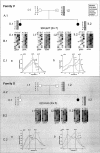Evidence that paternal expression of the epsilon-sarcoglycan gene accounts for reduced penetrance in myoclonus-dystonia
- PMID: 12444570
- PMCID: PMC378568
- DOI: 10.1086/344531
Evidence that paternal expression of the epsilon-sarcoglycan gene accounts for reduced penetrance in myoclonus-dystonia
Abstract
Myoclonus-dystonia (M-D) is a movement disorder characterized by rapid muscle contractions and sustained twisting and repetitive movements and has recently been associated with mutations in the epsilon-sarcoglycan gene (SGCE). The mode of inheritance is autosomal dominant with reduced penetrance upon maternal transmission, suggesting a putative maternal imprinting mechanism. We present an apparently sporadic M-D case and two patients from an M-D family with seemingly autosomal recessive inheritance. In both families, we detected an SGCE mutation that was inherited from the patients' clinically unaffected fathers in an autosomal dominant fashion. Whereas, in the first family, RNA expression studies revealed expression of only the mutated allele in affected individuals and expression of the normal allele exclusively in unaffected mutation carriers, the affected individual of the second family expressed both alleles. In addition, we identified differentially methylated regions in the promoter region of the SGCE gene as a characteristic feature of imprinted genes. Using a rare polymorphism in the promoter region in a family unaffected with M-D as a marker, we demonstrated methylation of the maternal allele, in keeping with maternal imprinting of the SGCE gene. Loss of imprinting in the patient with M-D who had biallelic expression of the SGCE gene was associated with partial loss of methylation at several CpG dinucleotides.
Figures


Similar articles
-
The epsilon-sarcoglycan gene (SGCE), mutated in myoclonus-dystonia syndrome, is maternally imprinted.Eur J Hum Genet. 2003 Feb;11(2):138-44. doi: 10.1038/sj.ejhg.5200938. Eur J Hum Genet. 2003. PMID: 12634861
-
Genetic heterogeneity in ten families with myoclonus-dystonia.J Neurol Neurosurg Psychiatry. 2004 Aug;75(8):1181-5. doi: 10.1136/jnnp.2003.027177. J Neurol Neurosurg Psychiatry. 2004. PMID: 15258227 Free PMC article.
-
Myoclonus-dystonia: detection of novel, recurrent, and de novo SGCE mutations.Neurology. 2004 Apr 13;62(7):1229-31. doi: 10.1212/01.wnl.0000118286.75059.35. Neurology. 2004. PMID: 15079037 No abstract available.
-
Twenty years on: Myoclonus-dystonia and ε-sarcoglycan - neurodevelopment, channel, and signaling dysfunction.Mov Disord. 2019 Nov;34(11):1588-1601. doi: 10.1002/mds.27822. Epub 2019 Aug 26. Mov Disord. 2019. PMID: 31449710 Review.
-
Dystonia-plus syndromes.Eur J Neurol. 2010 Jul;17 Suppl 1:37-45. doi: 10.1111/j.1468-1331.2010.03049.x. Eur J Neurol. 2010. PMID: 20590807 Review.
Cited by
-
[Genetics of movement disorders].Nervenarzt. 2013 Feb;84(2):143-50. doi: 10.1007/s00115-012-3638-y. Nervenarzt. 2013. PMID: 23354823 Review. German.
-
Diagnosis of dystonic syndromes--a new eight-question approach.Nat Rev Neurol. 2012 Mar 20;8(5):275-83. doi: 10.1038/nrneurol.2012.39. Nat Rev Neurol. 2012. PMID: 22430107 Review.
-
An Asian Patient with Myoclonus-Dystonia (DYT11) Responsive to Deep Brain Stimulation of the Globus Pallidus Internus.Case Rep Neurol Med. 2014;2014:937095. doi: 10.1155/2014/937095. Epub 2014 Feb 9. Case Rep Neurol Med. 2014. PMID: 24716024 Free PMC article.
-
Association of aberrant ASNS imprinting with asparaginase sensitivity and chromosomal abnormality in childhood BCP-ALL.Blood. 2020 Nov 12;136(20):2319-2333. doi: 10.1182/blood.2019004090. Blood. 2020. PMID: 32573712 Free PMC article.
-
Non-coding RNAs in muscle differentiation and musculoskeletal disease.J Clin Invest. 2016 Jun 1;126(6):2021-30. doi: 10.1172/JCI84419. Epub 2016 Jun 1. J Clin Invest. 2016. PMID: 27249675 Free PMC article. Review.
References
Electronic-Database Information
-
- Center for Medical Genetics, Marshfield Medical Research Foundation, http://research.marshfieldclinic.org/genetics/
-
- GenBank, http://www.ncbi.nlm.nih.gov/Genbank/ (for SGCE [accession number NM_003919])
-
- Online Mendelian Inheritance in Man (OMIM), http://www.ncbi.nlm.nih.gov/Omim/ (for SGCE [MIM 604149] and M-D [MIM 159900])
References
-
- Asmus F, Zimprich A, Naumann M, Berg D, Bertram M, Ceballos-Baumann A, Pruszak-Seel R, Kabus C, Dichgans M, Fuchs S, Müller-Myhsok B, Gasser T (2001) Inherited myoclonus-dystonia syndrome: narrowing the 7q21-q31 locus in German families. Ann Neurol 49:121–124 - PubMed
-
- Gasser T (1998) Inherited myoclonus-dystonia syndrome. Adv Neurol 78:325–334 - PubMed
-
- Grabowski M, Zimprich A, Lorenz-Depiereux B, Asmus F, Bauer M, Kalscheuer VM, Gasser T, Meitinger T, Strom TM (2002) Epsilon-sarcoglycan (SGCE), the gene mutated in myoclonus-dystonia syndrome, is imprinted. Paper presented at the 34th European Society of Human Genetics Conference, Strassbourg, France, May 25–28
-
- Klein C (2002) Myoclonus and myoclonus-dystonias. In: Pulst S (ed) Genetics of movement disorders. Academic Press, San Diego, pp 449–469
Publication types
MeSH terms
Substances
Associated data
- Actions
- Actions
- Actions
LinkOut - more resources
Full Text Sources
Medical
Molecular Biology Databases

